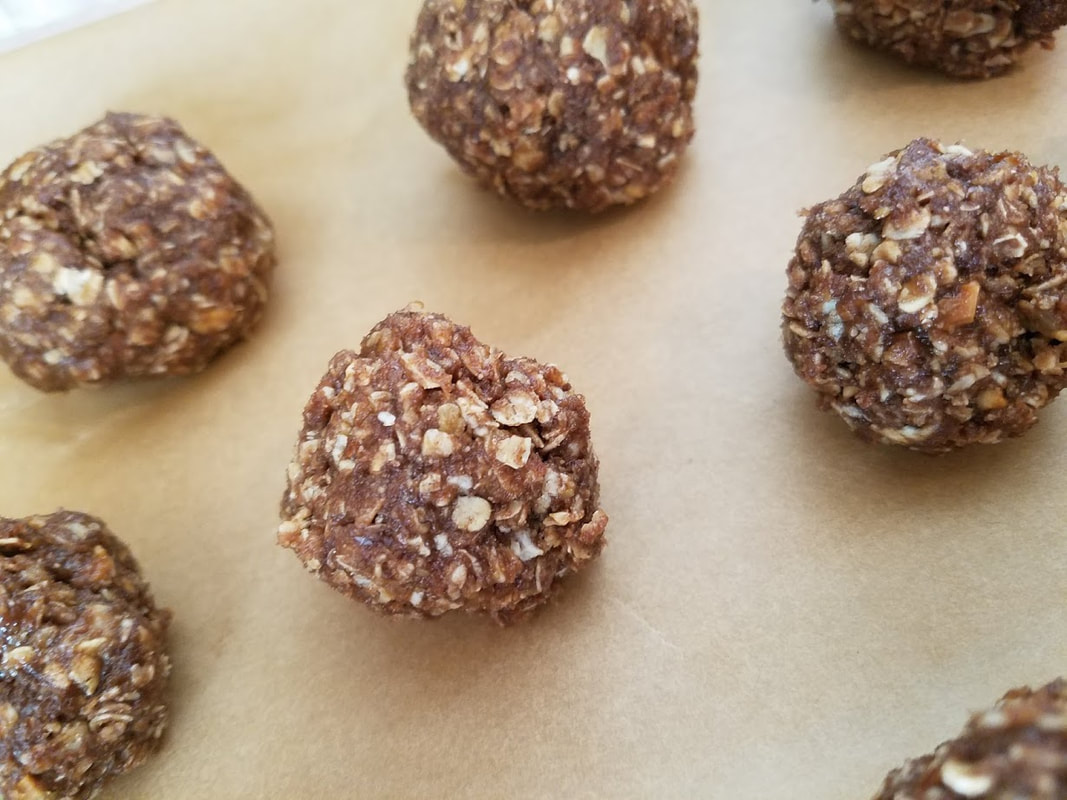 A nice easy "go to" breakfast for our go-go little man are these PB Balls. These delicious bites are about 120 calories and 5g protein, with 3 g of fiber and a nice dose of omega-3 fatty acids per ball (depending on size), and are intended for the child who needs a higher calorie healthy snacks. To make this healthy snack click here.
0 Comments
It has been awhile since I have posted, and over these past few years, a lot has happened in my life. I have struggled with infertility, had a child, lost a parent, moved to Oregon, and found new passions in my life. During this hiatus, I have also worked on my own personal development as a human being (emotional and physical.) It's amazing how having a child can motivate you to be your best in every aspect of life. All of this growth has changed my perspective and attitude, and has allowed me to experience new things in order to help others. In the upcoming months, I will be spotlighting a new topic that I have personally dealt with or are currently working on. I will be shedding light on these subjects with science and personal truths that will hopefully help you along your journey.
With that said, let's get started! 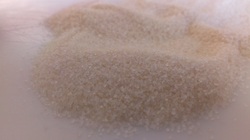 You may have heard about the new book by Eve Schaub called, “Year of No Sugar”. I have not had the opportunity to review this book yet, but have read several reviews about the content. This article is not intended to review this book, but to spark a challenge about how much “added” sugar is actually in your current diet. I am not focusing on certain types of sugars (i.e. fructose) that were omitted in Schaub book, but just any type of added sugar. So what is added sugar? “Added sugars are sugars and syrups that are added to foods or beverages when they are processed or prepared. This does not include naturally occurring sugars such as those in milk and fruits.”1 I feel I eat pretty healthy, and do indulge every so often, but I have noticed there are some unnecessary added sugars in my diet. Why should someone care about this? Added sugars are unnecessary empty calories that are typically stored as fat. They have also been linked to increased cardiovascular disease risk, weight gain, obesity, and can increase risk of diabetes. Sugar can also affect our mood and can cause act as an addiction as injection of it can trigger the release of chemicals such as serotonin, opioids and dopamine. Over time, people can develop a tolerance for sugar, meaning they need more sugar for a feel-good "fix”. This can cause a downward spiral in our overall health. I could go on as the reasons to limit added sugar are plentifully, but for the sake of time, let’s get started! I am taking a 30 day no added sugar challenge and I challenge you the reader, to do the same. To help you along the way, I am including a list of items and ingredients to look for to avoid added sugar in your challenge. Typical products you want to be wary of are:
Just cutting out added sugars is a challenge in itself, but if you want to make it a super-challenge, try cutting out all artificial sweeteners as well!! Your health and sweet tooth may thank you! References 1http://www.choosemyplate.gov/weight-management-calories/calories/added-sugars.html http://health.clevelandclinic.org/2014/04/added-sugar-added-risk-for-your-heart/ http://www.prevention.com/food/healthy-eating-tips/weird-effects-sugars-having-your-body 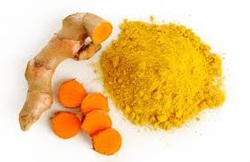 Turmeric goes by many names but it is commonly called Curcuma longa (domesticated) or Cucuma aromatic (in the wild). It is a relative of ginger, and is a perennial that grows in the tropical regions of Southern Asia. Its roots are bulbs that produce rhizomes (underground plant stems). Although it grows in many tropical locations, the majority of turmeric is grown in India and is used as a main ingredient in curry. It is also used as a medicinal herb in Ayurvedic and traditional Chinese medicine. Turmeric contains protein (6.3%), fat (5.1%), minerals (3.5%, carbohydrate (69.4%), and moisture (13.1%). The spice Turmeric has a warm, bitter taste, and is frequently used to flavor and color curry powders, mustards, butters, and cheeses. It is considered safe in cooking with minimal side effects. Alone or added to other spices, herbs, and aromatics, turmeric can boost the flavor of many dishes such as rice, chicken, turkey, vegetables or even salad dressing. It's also commonly used in pickling recipes to provide a zingy, tangy taste as well. Turmeric is best absorbed when combined with black pepper. Medicinal Purposes There has been a lot research done on the therapeutic advantages of turmeric and curcumin; almost too numerous to list. An overview published in Advanced Experimental Medical Biology in 2007 states that, "Curcumin has been shown to exhibit antioxidant, anti-inflammatory, antiviral, antibacterial, antifungal, and anticancer activities and thus has a potential against various malignant diseases, diabetes, allergies, arthritis, Alzheimer's disease and other chronic illnesses." This article will highlight a few of the more researched areas. Turmeric has been used for 4,000 years to treat a variety of conditions. In both Ayurvedic and Chinese medicine, it is used as an anti-inflammatory agent to treat digestive and liver problems, skin diseases, and wounds. Curcumin, the phytochemical found in turmeric, has been studied as a powerful antioxidant and has anti-inflammatory properties. It is the most active constituent of turmeric with very few side-effects and is generally considered safe; however, some people can experience stomach upset, nausea, dizziness, or diarrhea. Neither curcumin nor turmeric taken orally is well absorbed unless taken with black pepper or piperine, a constituent of black pepper responsible for its pungency. Curcumin has been shown in animal studies to stimulate the gallbladder to produce bile acids, which some people think may help improve digestion. One double-blinded, placebo-controlled study found that turmeric reduced symptoms of bloating and gas in people suffering from indigestion. On the other hand, turmeric does not seem to help treat stomach ulcers. In fact, there is some evidence that it may increase stomach acid, making existing ulcers worse. Studies of turmeric and curcumin have also shown to work as a non-steroidal anti-inflammatory drug for treatment of osteoarthritis; act as a weak phytoestrogen with some cancer protective effects; induces programmed death of colon cancer cells; and suppresses microinflammation in the GI tract associated with inflammatory bowel disease. The bottom line Turmeric and curcumin may have some exciting health properties, but there are not enough definitive human studies to make any recommendations at this time. Most of the research I have reviewed involved the extract curcumin. Until there is an extensive amount of data that the supplement is best, cooking with turmeric may be the best way to go. Whole foods are generally better and safer for the body. This article only suggests using turmeric as a spice in cooking. If you wish to take turmeric or curcumin as a supplement, please speak with your medical provider before doing so, as it can interfere with other drugs you may be taking and may not be safe for use for people who are undergoing chemotherapy, pregnancy, have GERD, or have gallstones. Turmeric may also slow blood clotting and taking turmeric along with anti-clotting medications might increase the chances of bruising and bleeding. Recipe Bobby Flay’s Oven Roasted Cauliflower with Turmeric and Ginger Courtesy of the food network.com (http://www.foodnetwork.com/recipes/bobby-flay/oven-roasted-cauliflower-with-turmeric-and-ginger-recipe.html?oc=linkback) Ingredients 3 tablespoons vegetable oil 1 tablespoon black mustard seeds 1 jalapeno, finely diced 1 tablespoon grated fresh ginger 1 teaspoon turmeric 1 head cauliflower, cut into florets Salt Directions Preheat oven to 425 degrees F. Whisk together the oil, mustard seeds, jalapeno, ginger, and turmeric in a small bowl. Place cauliflower in a medium baking dish and toss with the flavored oil and season with salt. Roast until lightly golden brown and just tender, 20 to 25 minutes. Serve hot. References
http://www.webmd.com/vitamins-supplements/ingredientmono-662-TURMERIC.aspx?activeIngredientId=662&activeIngredientName=TURMERIC http://www.3fatchicks.com/4-easy-ways-to-cook-with-turmeric/ http://www.drweil.com/drw/u/QAA400915/Curcumin-or-Turmeric.html http://www.huffingtonpost.com/andrew-weil-md/turmeric-health-have-a-happy-new-year_b_798328.html Chattopadhyay I. Biswas K, et al. Turmeric and curcumin: Biological actions and medicinal applications. Current Science. 87 (1): 44-53, 2004 Liu J Chen S, et al. Recent progress in studying curcumin and its nano-preperations for cancer therapy. Current Pharmaceutical Design. 19 (11): 1974-93, 2013 Asher GN Speiman K. Clinical utility of curcumin extract. Altern Ther Health Med. 19(2):20-2, 2013. Asher GN Speiman K. Clinical utility of curcumin extract. Altern Ther Health Med. 19(2):20-2, 2013. 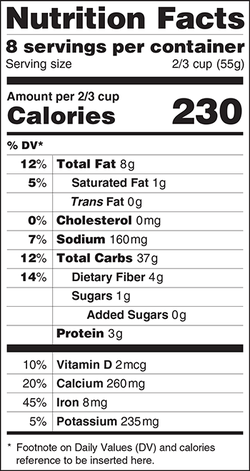 By now you may have heard about the proposed new food label proposed by the FDA but are you aware how this may impact you? The FDA, in an attempt to align with the current scientific literature and nutritional recommendations, is updating the food labels. The following is the proposed label and the significant changes. The serving sizes are more in line with typical serving sizes one would eat and the total serving per container is accentuated. The “Calories” per serving print is very large and stands out and may be dramatically changed due to the new serving size guidelines proposed. First some background. The FDA set the current reference values (Reference Amounts Customarily Consumed, or RACCs), in 1994, which were based on Nationwide Food Consumption Surveys. More recent food consumption data show about 17% of the current RACCs should be changed for different food categories. In addition, the FDA is also proposing to add 25 new RACCS. The FDA is also proposing to require that some food products previously labeled as more than one serving be labeled as a single serving, because people typically eat or drink them in one sitting. Food packages containing between 150% and 200% of the RACCs could no longer be labeled as more than one serving. Certain larger packages that could be consumed in one sitting or in multiple sittings would be required to be labeled per serving and per package. This dual column labeling would be required if a package contained at least 200% of the RACC and less than or equal to 400% of the RACC. Packages containing more than 400% of the RACC, dual column labeling would not be required.2 Some other evident changes are the switch up of the %DV and the total grams will be on opposite sides to allow the consumer make better choices based on their overall daily intake. Other less evident changes is the requirement of “added sugars” on the label. Having this added to the product will immediately let you know if the sugars contained in the product are naturally occurring or added which makes a big difference in the overall nutritional benefit of the food item. Potassium and vitamin D will also be required on food labels which are important for chronic disease management. Vitamins A and C would no longer be required on the label. The Daily Values for sodium, dietary fiber and Vitamin D were reevaluated to current recommendations for overall health. “Total Fat,” “Saturated Fat,” and “Trans Fat” remain the same as the current label, the “Calories from Fat” would be removed to reflect current research which shows the type of fat is more important than the amount. The changes proposed will affect all packaged foods with the exception of certain meat, poultry and processed egg products, which are regulated by the U.S. Department of Agriculture’s Food Safety and Inspection Service. So, with that all said, how will it change the way you shop? The changes in the serving size are pretty important. I don’t know how many times I have picked up an item and wondered if people actually adhere to the serving size on the package. It is definitely misleading and causes confusion for some. It will also make product comparisons a little easier. For instance, most soft drinks will be considered a serving size instead of 1 ½ --2 servings as they currently are making it easily for the consumer to see how many non-nutritive calories there really are consuming in the product without having to do math. The one change I am most excited about is the “added sugar” line addition, as I feel it will be a very helpful feature. I’d have to say that most people are not aware of the amount of added sugar in products and I think it will be an eye opening fact for most. Will it change the way you purchase items? I hope, but at least it will make the consumer more aware. This week’s recipe is taken from Health-bent http://www.health-bent.com/sides/paleo-pad-thai Low Carb Pad Thai Ingredients
If you have a mandolin, slicing the zucchinis lengthwise. If you don’t have one you can use a knife to slice the zucchini as thinly as you can (lengthwise). Slice the slices into thin strips, just like the shape of a spaghetti noodle. Over medium heat, melt your fat of choice. Saute the onion, garlic and ginger, until soft. Add the fish sauce, chili sauce, vinegar, lime juice, almond butter and a bit of salt. Stir to combine. Add the zucchini noodles to the sauté pan. Stir them around to get the sauce incorporated onto the “zoodles”. The point here is get the "zoodles" hot and very slightly cooked through (just like an al dente noodle!), about 10 minutes. Serve hot. Any kind of grilled or pan seared meat or seafood would go really well with this. ------------------------------------------------------------------------------------------------------------------------------------------------ References: http://www.fda.gov/NewsEvents/Newsroom/PressAnnouncements/ucm387418.htm 2http://www.fda.gov/Food/GuidanceRegulation/GuidanceDocumentsRegulatoryInformation/LabelingNutrition/ucm387533.htm 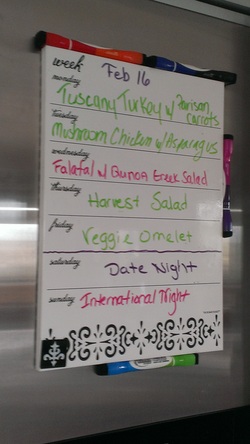 Are you starting to get stuck? Some of the best intentions can be met with challenges. We lead such busy lives that it is hard to find “time” to do the things we should be doing. I cannot tell you how many times a day I hear, “I’d love to do that, but I just don’t have the time.” Well I hate to burst the bubble here but time is relative. All we need to do is create time! I know this may sound easier than it is, but it really is that easy! As soon as you say those words, “I don’t have time”, you already set yourself up for failure. Try to change your thoughts and words and say, “I will make time”. You will be surprised at what you can fit in when you change the way you think. With that said here are some tips to “save-time” and therefore allow you to stick to your plan. - Make a Menu Board. I don’t know how many times this has happened to me. I get home from work and had good intention to make something fabulous for dinner, but get home and just make something quick and easy, but not necessarily healthy. I am not saying quick and easy cannot be healthy, but a lot of times unhealthy food can be easy to just through in or pick-up. - To go along with the menu board, you will need to plan your meals in advance. This will also help with your shopping trip and will discourage you from buying those unhealthy impulse items that somehow end up in our carts. We sit down every Sat morning and go through the refrigerator and plan meals for the upcoming week, make a list, then hot Trader Joe's and Sprouts (we are very lucky to have these awesome stores!!) - Prep your lunch the night before. This way you can take your time to make a nice healthy lunch. You can also do this with breakfast (depending on what you have in the morning, I have a protein shake so it works great for me! - Make a work-out schedule. Sometimes when we are forced to write things down, it makes us a little more accountable. There are also some great apps out there that will get you motivated. http://www.pcmag.com/slideshow/story/292474/the-25-best-fitness-apps - Set out your work-out gear the night before. This way it is ready to go for you in the morning, Hope this helps! Recipe of the Week
Mushroom Chicken with Asparagus Ingredients: 2 Chicken breasts Salt (to taste) Pepper (to taste) 1 tbs Olive Oil / Avocado Oil 1 bunch Asparagus (washed and cut) 1/2 cup Feta Cheese Mushroom Basil Sauce (courtesy of allrecipies.com) http://allrecipes.com/recipe/basil-cream-sauce/ Directions: Preheat oven to 350 degrees. Use a meat mallet and pound out the chicken breasts so they are about ½ inch thick. Boil water and place asparagus in water until blanched. Dry and set aside. Place asparagus on chicken with feta cheese (divide between the 2 breasts), wrap and set aside. Heat olive oil in saucepan over medium heat. Place chicken breast in skillet and brown on both sides. Place in baking dish and drizzle with olive or avocado oil. Finish in the oven for ~30min or until 165 degrees. Make Basil sauce and pour over chicken. |
Author
I love to share my knowledge about nutrition and wellness. Please feel free to contact me for topic requests. Archives
March 2020
Categories
All
|
Colene Stoernell MS, RDN, LD
 RSS Feed
RSS Feed
